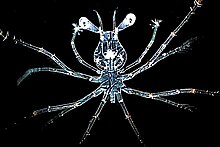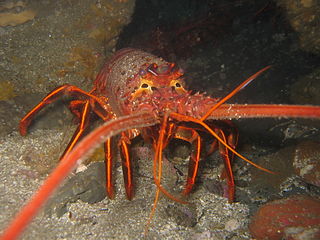
Spiny lobsters, also known as langustas, langouste, or rock lobsters, are a family (Palinuridae) of about 60 species of achelate crustaceans, in the Decapoda Reptantia. Spiny lobsters are also, especially in Australia, New Zealand, Ireland, South Africa, and the Bahamas, called crayfish, sea crayfish, or crawfish, terms which elsewhere are reserved for freshwater crayfish.

The California spiny lobster is a species of spiny lobster found in the eastern Pacific Ocean from Monterey Bay, California, to the Gulf of Tehuantepec, Mexico. It typically grows to a length of 30 cm (12 in) and is a reddish-brown color with stripes along the legs, and has a pair of enlarged antennae but no claws. The interrupted grooves across the tail are characteristic for the species.

Jasus edwardsii, the southern rock lobster, red rock lobster, or spiny rock lobster, is a species of spiny lobster found throughout coastal waters of southern Australia and New Zealand including the Chatham Islands. It is commonly called crayfish in Australia and New Zealand and kōura in Māori. They resemble lobsters, but lack the large characteristic pincers on the first pair of walking legs.

The Achelata is an infra-order of the decapod crustaceans, holding the spiny lobsters, slipper lobsters and their fossil relatives.

Slipper lobsters are a family (Scyllaridae) of about 90 species of achelate crustaceans, in the Decapoda clade Reptantia, found in all warm oceans and seas. They are not true lobsters, but are more closely related to spiny lobsters and furry lobsters. Slipper lobsters are instantly recognisable by their enlarged antennae, which project forward from the head as wide plates. All the species of slipper lobsters are edible, and some, such as the Moreton Bay bug and the Balmain bug are of commercial importance.

Astacidea is an infraorder of decapod crustaceans including lobsters, crayfish, and their close relatives.
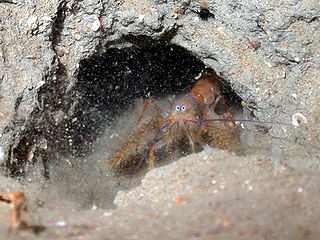
Furry lobsters are small decapod crustaceans, closely related to the slipper lobsters and spiny lobsters. The antennae are not as enlarged as in spiny and slipper lobsters, and the body is covered in short hairs, hence the name furry lobster. Although previously considered a family in their own right, the furry lobsters were subsumed into the family Palinuridae in 1990,. Subsequent molecular phylogenetics studies have confirmed that the furry lobsters genera don't form a natural group and were both nested among the spiny lobster genera in family Palinuridae. The family now includes the two furry lobster genera and ten spiny lobster genera.
Palibythus magnificus, sometimes called the musical furry lobster, is a species of furry lobster found in Polynesia. It is generally included in the family Palinuridae, although it has also been separated from that family with the genus Palinurellus to form the family Synaxidae in the past. The species is known in Samoan as ula moana, a name which also covers the deep-water shrimp Heterocarpus laevigatus.

Palinurus elephas is a commonly caught species of spiny lobster from the East Atlantic Ocean and the Mediterranean Sea. Its common names include European spiny lobster, crayfish or cray, crawfish, common spiny lobster, Mediterranean lobster and red lobster.

Scyllarides latus, the Mediterranean slipper lobster, is a species of slipper lobster found in the Mediterranean Sea and in the eastern Atlantic Ocean. It is edible and highly regarded as food, but is now rare over much of its range due to overfishing. Adults may grow to 1 foot (30 cm) long, are camouflaged, and have no claws. They are nocturnal, emerging from caves and other shelters during the night to feed on molluscs. As well as being eaten by humans, S. latus is also preyed upon by a variety of bony fish. Its closest relative is S. herklotsii, which occurs off the Atlantic coast of West Africa; other species of Scyllarides occur in the western Atlantic Ocean and the Indo-Pacific. The larvae and young animals are largely unknown.

Parribacus japonicus, the Japanese mitten lobster, is a species of slipper lobster. Though the common name for this lobster is the Japanese mitten lobster, it is locally called zōri-ebi (ゾウリエビ) – zōri denoting the Japanese sandal it resembles, and ebi meaning shrimp or lobster.

Crustaceans may pass through a number of larval and immature stages between hatching from their eggs and reaching their adult form. Each of the stages is separated by a moult, in which the hard exoskeleton is shed to allow the animal to grow. The larvae of crustaceans often bear little resemblance to the adult, and there are still cases where it is not known what larvae will grow into what adults. This is especially true of crustaceans which live as benthic adults, more-so than where the larvae are planktonic, and thereby easily caught.

Palinurus mauritanicus is a species of spiny lobster. It is found in deep waters in the eastern Atlantic Ocean and the western Mediterranean Sea.
Scyllarus pygmaeus is a species of slipper lobster that lives in shallow water in the Mediterranean Sea and eastern Atlantic Ocean. It grows to a length of 55 mm (2.2 in), which is too small for it to be fished for food. The juvenile form was first described in 1885, with the description of the adult following in 1888 as a result of the Challenger expedition.

Palinurus charlestoni is a species of spiny lobster which is endemic to the waters of Cape Verde. It grows to a total length of 50 cm (20 in) and can be distinguished from other Atlantic species in the genus by the pattern of horizontal bands on its legs. It was discovered by French fishermen in 1963, and has been the subject of small-scale fishery since. It is thought to be overexploited, and is listed as Near Threatened on the IUCN Red List.

Cancrinos is a genus of fossil crustaceans closely allied with the slipper lobsters. One species is known, C. claviger from the Jurassic of southern Germany.
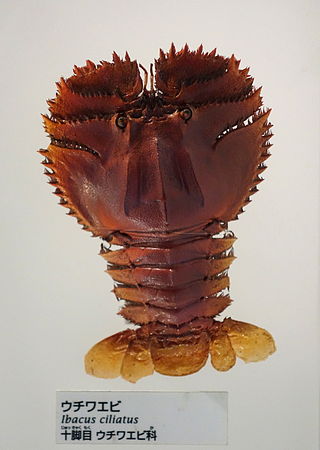
Ibacus ciliatus is a species of slipper lobster from the north-west Pacific Ocean.

Scyllarides squammosus is a species of slipper lobster known as the blunt slipper lobster. It is found throughout the Indo-West Pacific region. Specifically its range is from Australia, Japan, Hawaii, Melanesia, New Caledonia to East Africa. Scyllarides squammosus has been found at depths from 7.5 m to 71 m.
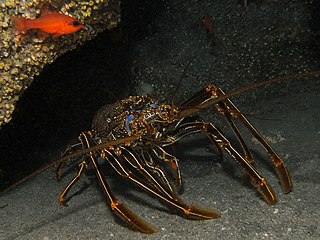
Panulirus echinatus, the brown spiny lobster, is a species of spiny lobster that lives on rocky reefs in the tropical western Atlantic Ocean and central Atlantic Islands.
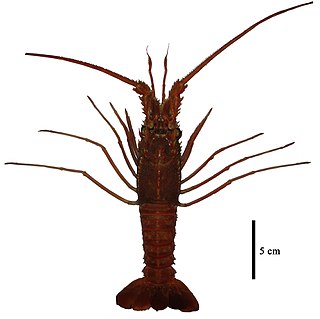
Puerulus, commonly known as whip lobsters, is a genus of spiny lobsters in the family Palinuridae, native to the Indo-Pacific at depths of 200 to 700 meters.

